Nursing Australia Case Study 2022
VerifiedAdded on 2022/10/01
|9
|2135
|36
AI Summary
Contribute Materials
Your contribution can guide someone’s learning journey. Share your
documents today.
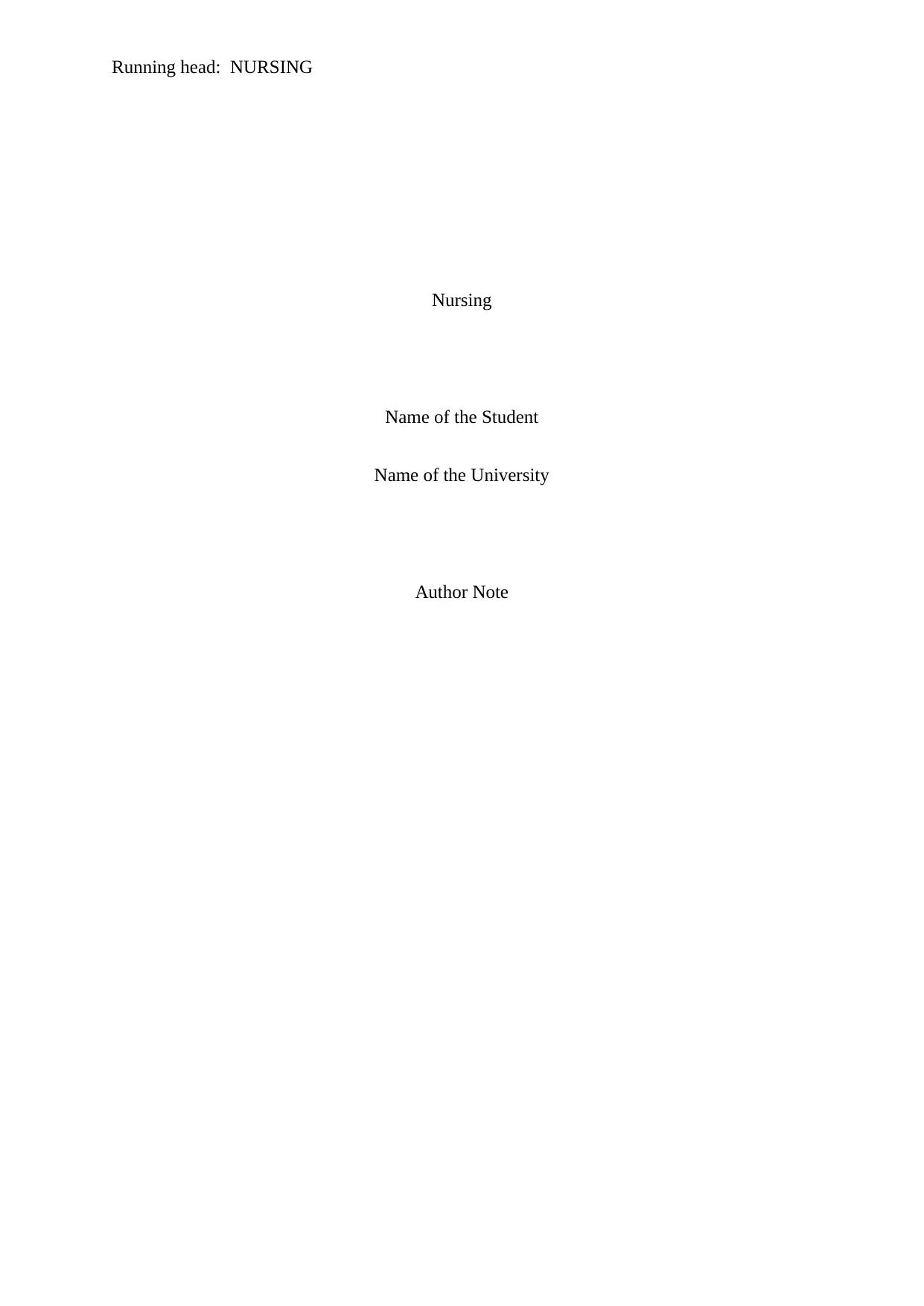
Running head: NURSING
Nursing
Name of the Student
Name of the University
Author Note
Nursing
Name of the Student
Name of the University
Author Note
Secure Best Marks with AI Grader
Need help grading? Try our AI Grader for instant feedback on your assignments.
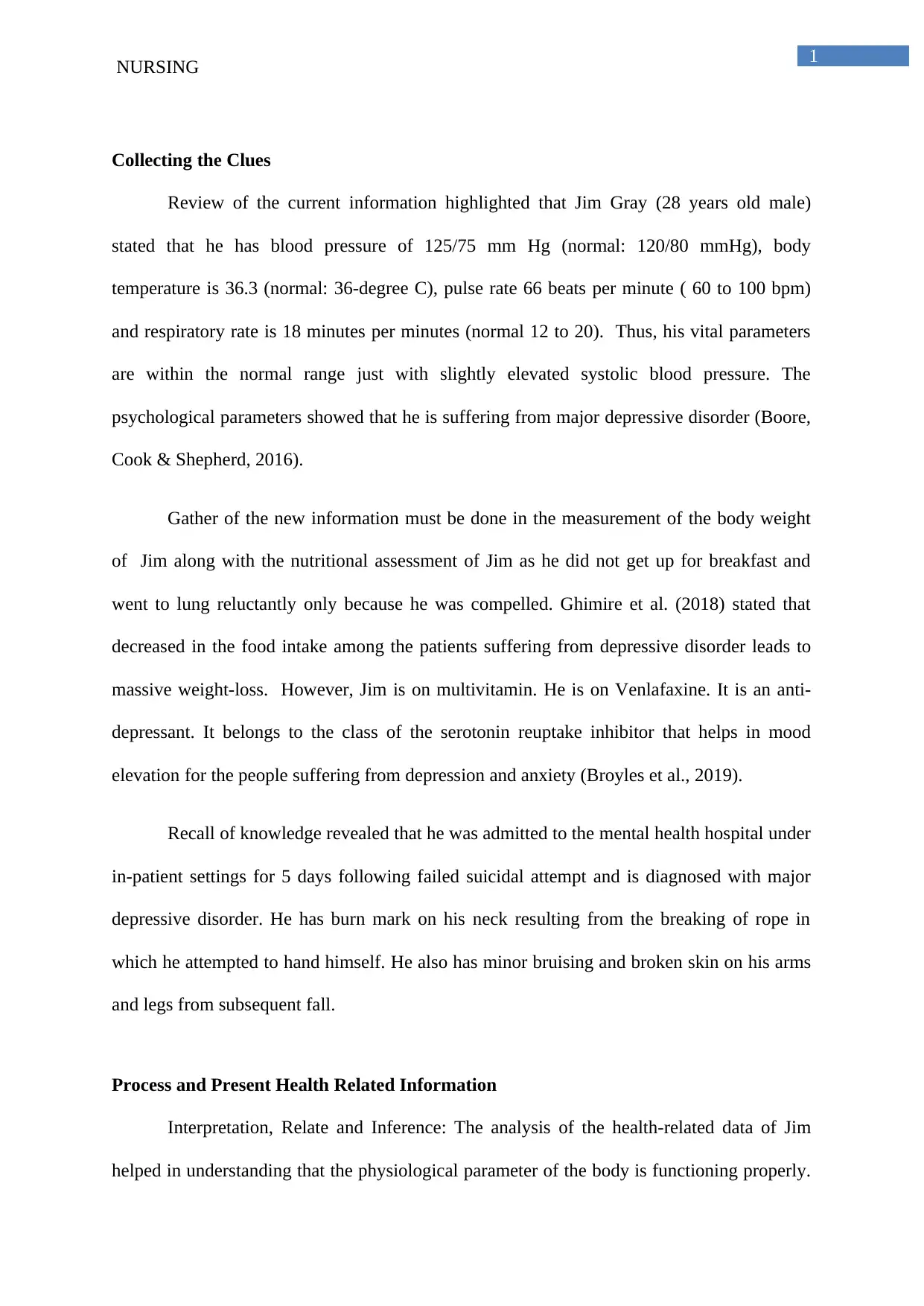
1
NURSING
Collecting the Clues
Review of the current information highlighted that Jim Gray (28 years old male)
stated that he has blood pressure of 125/75 mm Hg (normal: 120/80 mmHg), body
temperature is 36.3 (normal: 36-degree C), pulse rate 66 beats per minute ( 60 to 100 bpm)
and respiratory rate is 18 minutes per minutes (normal 12 to 20). Thus, his vital parameters
are within the normal range just with slightly elevated systolic blood pressure. The
psychological parameters showed that he is suffering from major depressive disorder (Boore,
Cook & Shepherd, 2016).
Gather of the new information must be done in the measurement of the body weight
of Jim along with the nutritional assessment of Jim as he did not get up for breakfast and
went to lung reluctantly only because he was compelled. Ghimire et al. (2018) stated that
decreased in the food intake among the patients suffering from depressive disorder leads to
massive weight-loss. However, Jim is on multivitamin. He is on Venlafaxine. It is an anti-
depressant. It belongs to the class of the serotonin reuptake inhibitor that helps in mood
elevation for the people suffering from depression and anxiety (Broyles et al., 2019).
Recall of knowledge revealed that he was admitted to the mental health hospital under
in-patient settings for 5 days following failed suicidal attempt and is diagnosed with major
depressive disorder. He has burn mark on his neck resulting from the breaking of rope in
which he attempted to hand himself. He also has minor bruising and broken skin on his arms
and legs from subsequent fall.
Process and Present Health Related Information
Interpretation, Relate and Inference: The analysis of the health-related data of Jim
helped in understanding that the physiological parameter of the body is functioning properly.
NURSING
Collecting the Clues
Review of the current information highlighted that Jim Gray (28 years old male)
stated that he has blood pressure of 125/75 mm Hg (normal: 120/80 mmHg), body
temperature is 36.3 (normal: 36-degree C), pulse rate 66 beats per minute ( 60 to 100 bpm)
and respiratory rate is 18 minutes per minutes (normal 12 to 20). Thus, his vital parameters
are within the normal range just with slightly elevated systolic blood pressure. The
psychological parameters showed that he is suffering from major depressive disorder (Boore,
Cook & Shepherd, 2016).
Gather of the new information must be done in the measurement of the body weight
of Jim along with the nutritional assessment of Jim as he did not get up for breakfast and
went to lung reluctantly only because he was compelled. Ghimire et al. (2018) stated that
decreased in the food intake among the patients suffering from depressive disorder leads to
massive weight-loss. However, Jim is on multivitamin. He is on Venlafaxine. It is an anti-
depressant. It belongs to the class of the serotonin reuptake inhibitor that helps in mood
elevation for the people suffering from depression and anxiety (Broyles et al., 2019).
Recall of knowledge revealed that he was admitted to the mental health hospital under
in-patient settings for 5 days following failed suicidal attempt and is diagnosed with major
depressive disorder. He has burn mark on his neck resulting from the breaking of rope in
which he attempted to hand himself. He also has minor bruising and broken skin on his arms
and legs from subsequent fall.
Process and Present Health Related Information
Interpretation, Relate and Inference: The analysis of the health-related data of Jim
helped in understanding that the physiological parameter of the body is functioning properly.
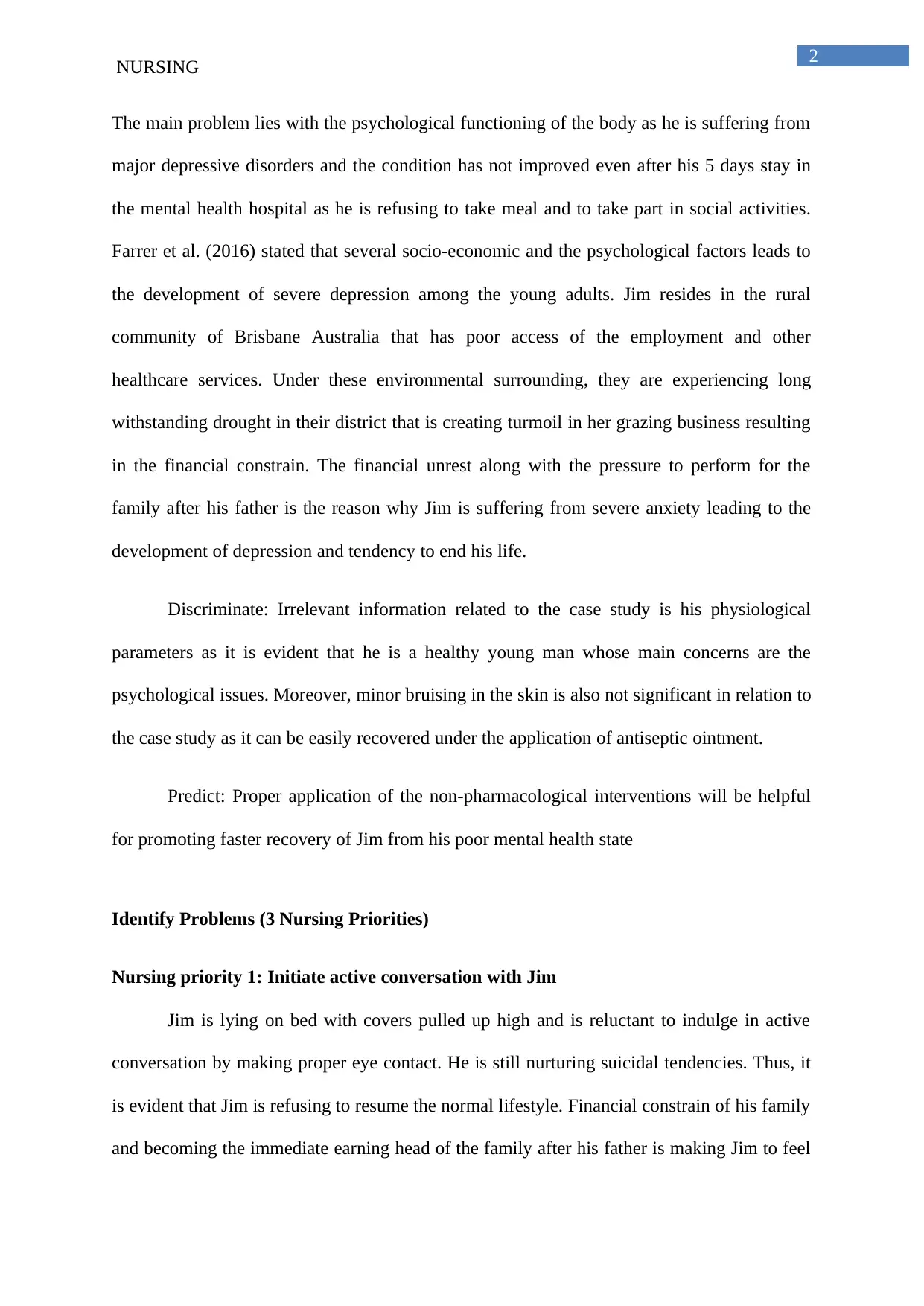
2
NURSING
The main problem lies with the psychological functioning of the body as he is suffering from
major depressive disorders and the condition has not improved even after his 5 days stay in
the mental health hospital as he is refusing to take meal and to take part in social activities.
Farrer et al. (2016) stated that several socio-economic and the psychological factors leads to
the development of severe depression among the young adults. Jim resides in the rural
community of Brisbane Australia that has poor access of the employment and other
healthcare services. Under these environmental surrounding, they are experiencing long
withstanding drought in their district that is creating turmoil in her grazing business resulting
in the financial constrain. The financial unrest along with the pressure to perform for the
family after his father is the reason why Jim is suffering from severe anxiety leading to the
development of depression and tendency to end his life.
Discriminate: Irrelevant information related to the case study is his physiological
parameters as it is evident that he is a healthy young man whose main concerns are the
psychological issues. Moreover, minor bruising in the skin is also not significant in relation to
the case study as it can be easily recovered under the application of antiseptic ointment.
Predict: Proper application of the non-pharmacological interventions will be helpful
for promoting faster recovery of Jim from his poor mental health state
Identify Problems (3 Nursing Priorities)
Nursing priority 1: Initiate active conversation with Jim
Jim is lying on bed with covers pulled up high and is reluctant to indulge in active
conversation by making proper eye contact. He is still nurturing suicidal tendencies. Thus, it
is evident that Jim is refusing to resume the normal lifestyle. Financial constrain of his family
and becoming the immediate earning head of the family after his father is making Jim to feel
NURSING
The main problem lies with the psychological functioning of the body as he is suffering from
major depressive disorders and the condition has not improved even after his 5 days stay in
the mental health hospital as he is refusing to take meal and to take part in social activities.
Farrer et al. (2016) stated that several socio-economic and the psychological factors leads to
the development of severe depression among the young adults. Jim resides in the rural
community of Brisbane Australia that has poor access of the employment and other
healthcare services. Under these environmental surrounding, they are experiencing long
withstanding drought in their district that is creating turmoil in her grazing business resulting
in the financial constrain. The financial unrest along with the pressure to perform for the
family after his father is the reason why Jim is suffering from severe anxiety leading to the
development of depression and tendency to end his life.
Discriminate: Irrelevant information related to the case study is his physiological
parameters as it is evident that he is a healthy young man whose main concerns are the
psychological issues. Moreover, minor bruising in the skin is also not significant in relation to
the case study as it can be easily recovered under the application of antiseptic ointment.
Predict: Proper application of the non-pharmacological interventions will be helpful
for promoting faster recovery of Jim from his poor mental health state
Identify Problems (3 Nursing Priorities)
Nursing priority 1: Initiate active conversation with Jim
Jim is lying on bed with covers pulled up high and is reluctant to indulge in active
conversation by making proper eye contact. He is still nurturing suicidal tendencies. Thus, it
is evident that Jim is refusing to resume the normal lifestyle. Financial constrain of his family
and becoming the immediate earning head of the family after his father is making Jim to feel
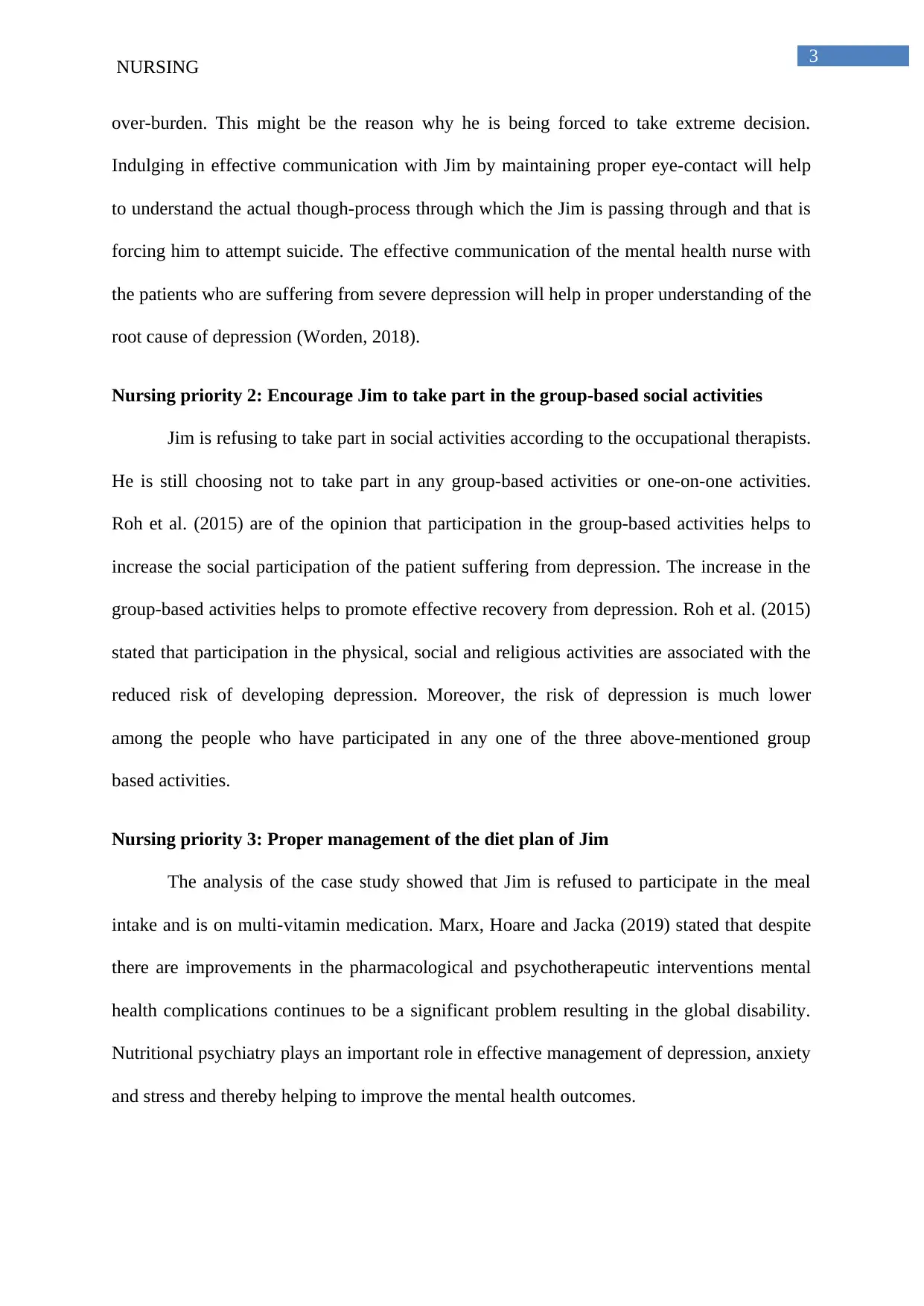
3
NURSING
over-burden. This might be the reason why he is being forced to take extreme decision.
Indulging in effective communication with Jim by maintaining proper eye-contact will help
to understand the actual though-process through which the Jim is passing through and that is
forcing him to attempt suicide. The effective communication of the mental health nurse with
the patients who are suffering from severe depression will help in proper understanding of the
root cause of depression (Worden, 2018).
Nursing priority 2: Encourage Jim to take part in the group-based social activities
Jim is refusing to take part in social activities according to the occupational therapists.
He is still choosing not to take part in any group-based activities or one-on-one activities.
Roh et al. (2015) are of the opinion that participation in the group-based activities helps to
increase the social participation of the patient suffering from depression. The increase in the
group-based activities helps to promote effective recovery from depression. Roh et al. (2015)
stated that participation in the physical, social and religious activities are associated with the
reduced risk of developing depression. Moreover, the risk of depression is much lower
among the people who have participated in any one of the three above-mentioned group
based activities.
Nursing priority 3: Proper management of the diet plan of Jim
The analysis of the case study showed that Jim is refused to participate in the meal
intake and is on multi-vitamin medication. Marx, Hoare and Jacka (2019) stated that despite
there are improvements in the pharmacological and psychotherapeutic interventions mental
health complications continues to be a significant problem resulting in the global disability.
Nutritional psychiatry plays an important role in effective management of depression, anxiety
and stress and thereby helping to improve the mental health outcomes.
NURSING
over-burden. This might be the reason why he is being forced to take extreme decision.
Indulging in effective communication with Jim by maintaining proper eye-contact will help
to understand the actual though-process through which the Jim is passing through and that is
forcing him to attempt suicide. The effective communication of the mental health nurse with
the patients who are suffering from severe depression will help in proper understanding of the
root cause of depression (Worden, 2018).
Nursing priority 2: Encourage Jim to take part in the group-based social activities
Jim is refusing to take part in social activities according to the occupational therapists.
He is still choosing not to take part in any group-based activities or one-on-one activities.
Roh et al. (2015) are of the opinion that participation in the group-based activities helps to
increase the social participation of the patient suffering from depression. The increase in the
group-based activities helps to promote effective recovery from depression. Roh et al. (2015)
stated that participation in the physical, social and religious activities are associated with the
reduced risk of developing depression. Moreover, the risk of depression is much lower
among the people who have participated in any one of the three above-mentioned group
based activities.
Nursing priority 3: Proper management of the diet plan of Jim
The analysis of the case study showed that Jim is refused to participate in the meal
intake and is on multi-vitamin medication. Marx, Hoare and Jacka (2019) stated that despite
there are improvements in the pharmacological and psychotherapeutic interventions mental
health complications continues to be a significant problem resulting in the global disability.
Nutritional psychiatry plays an important role in effective management of depression, anxiety
and stress and thereby helping to improve the mental health outcomes.
Secure Best Marks with AI Grader
Need help grading? Try our AI Grader for instant feedback on your assignments.
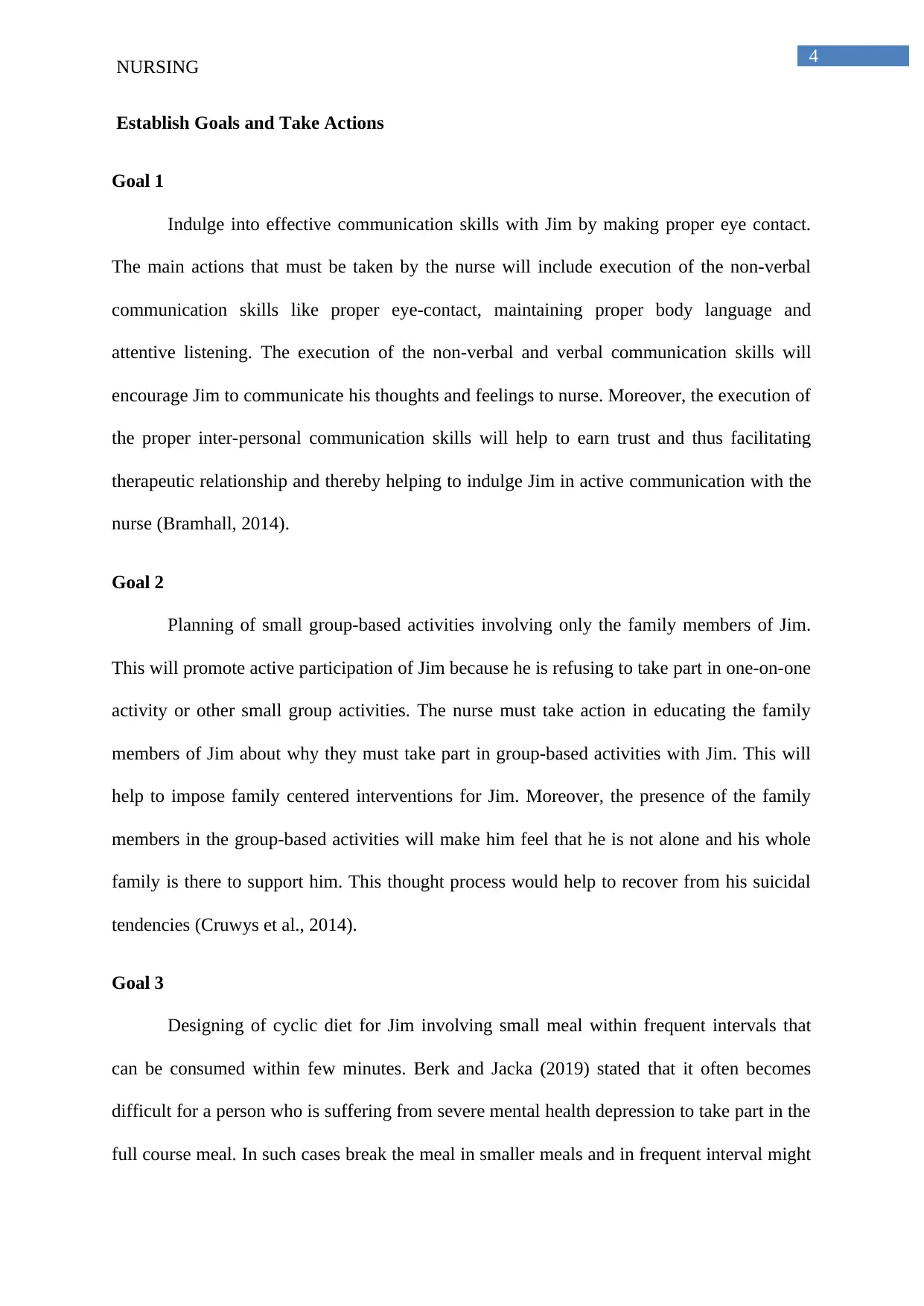
4
NURSING
Establish Goals and Take Actions
Goal 1
Indulge into effective communication skills with Jim by making proper eye contact.
The main actions that must be taken by the nurse will include execution of the non-verbal
communication skills like proper eye-contact, maintaining proper body language and
attentive listening. The execution of the non-verbal and verbal communication skills will
encourage Jim to communicate his thoughts and feelings to nurse. Moreover, the execution of
the proper inter-personal communication skills will help to earn trust and thus facilitating
therapeutic relationship and thereby helping to indulge Jim in active communication with the
nurse (Bramhall, 2014).
Goal 2
Planning of small group-based activities involving only the family members of Jim.
This will promote active participation of Jim because he is refusing to take part in one-on-one
activity or other small group activities. The nurse must take action in educating the family
members of Jim about why they must take part in group-based activities with Jim. This will
help to impose family centered interventions for Jim. Moreover, the presence of the family
members in the group-based activities will make him feel that he is not alone and his whole
family is there to support him. This thought process would help to recover from his suicidal
tendencies (Cruwys et al., 2014).
Goal 3
Designing of cyclic diet for Jim involving small meal within frequent intervals that
can be consumed within few minutes. Berk and Jacka (2019) stated that it often becomes
difficult for a person who is suffering from severe mental health depression to take part in the
full course meal. In such cases break the meal in smaller meals and in frequent interval might
NURSING
Establish Goals and Take Actions
Goal 1
Indulge into effective communication skills with Jim by making proper eye contact.
The main actions that must be taken by the nurse will include execution of the non-verbal
communication skills like proper eye-contact, maintaining proper body language and
attentive listening. The execution of the non-verbal and verbal communication skills will
encourage Jim to communicate his thoughts and feelings to nurse. Moreover, the execution of
the proper inter-personal communication skills will help to earn trust and thus facilitating
therapeutic relationship and thereby helping to indulge Jim in active communication with the
nurse (Bramhall, 2014).
Goal 2
Planning of small group-based activities involving only the family members of Jim.
This will promote active participation of Jim because he is refusing to take part in one-on-one
activity or other small group activities. The nurse must take action in educating the family
members of Jim about why they must take part in group-based activities with Jim. This will
help to impose family centered interventions for Jim. Moreover, the presence of the family
members in the group-based activities will make him feel that he is not alone and his whole
family is there to support him. This thought process would help to recover from his suicidal
tendencies (Cruwys et al., 2014).
Goal 3
Designing of cyclic diet for Jim involving small meal within frequent intervals that
can be consumed within few minutes. Berk and Jacka (2019) stated that it often becomes
difficult for a person who is suffering from severe mental health depression to take part in the
full course meal. In such cases break the meal in smaller meals and in frequent interval might
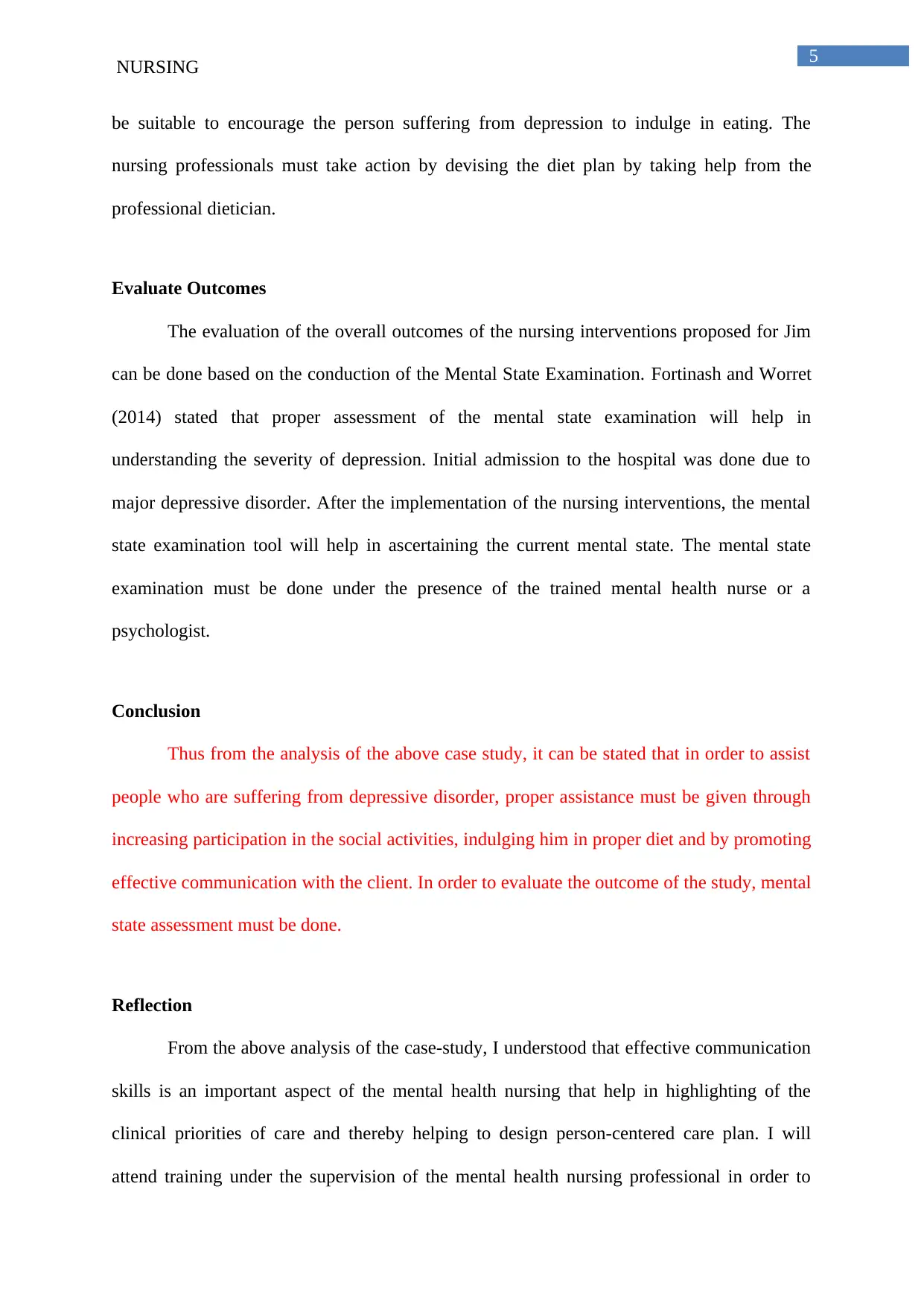
5
NURSING
be suitable to encourage the person suffering from depression to indulge in eating. The
nursing professionals must take action by devising the diet plan by taking help from the
professional dietician.
Evaluate Outcomes
The evaluation of the overall outcomes of the nursing interventions proposed for Jim
can be done based on the conduction of the Mental State Examination. Fortinash and Worret
(2014) stated that proper assessment of the mental state examination will help in
understanding the severity of depression. Initial admission to the hospital was done due to
major depressive disorder. After the implementation of the nursing interventions, the mental
state examination tool will help in ascertaining the current mental state. The mental state
examination must be done under the presence of the trained mental health nurse or a
psychologist.
Conclusion
Thus from the analysis of the above case study, it can be stated that in order to assist
people who are suffering from depressive disorder, proper assistance must be given through
increasing participation in the social activities, indulging him in proper diet and by promoting
effective communication with the client. In order to evaluate the outcome of the study, mental
state assessment must be done.
Reflection
From the above analysis of the case-study, I understood that effective communication
skills is an important aspect of the mental health nursing that help in highlighting of the
clinical priorities of care and thereby helping to design person-centered care plan. I will
attend training under the supervision of the mental health nursing professional in order to
NURSING
be suitable to encourage the person suffering from depression to indulge in eating. The
nursing professionals must take action by devising the diet plan by taking help from the
professional dietician.
Evaluate Outcomes
The evaluation of the overall outcomes of the nursing interventions proposed for Jim
can be done based on the conduction of the Mental State Examination. Fortinash and Worret
(2014) stated that proper assessment of the mental state examination will help in
understanding the severity of depression. Initial admission to the hospital was done due to
major depressive disorder. After the implementation of the nursing interventions, the mental
state examination tool will help in ascertaining the current mental state. The mental state
examination must be done under the presence of the trained mental health nurse or a
psychologist.
Conclusion
Thus from the analysis of the above case study, it can be stated that in order to assist
people who are suffering from depressive disorder, proper assistance must be given through
increasing participation in the social activities, indulging him in proper diet and by promoting
effective communication with the client. In order to evaluate the outcome of the study, mental
state assessment must be done.
Reflection
From the above analysis of the case-study, I understood that effective communication
skills is an important aspect of the mental health nursing that help in highlighting of the
clinical priorities of care and thereby helping to design person-centered care plan. I will
attend training under the supervision of the mental health nursing professional in order to
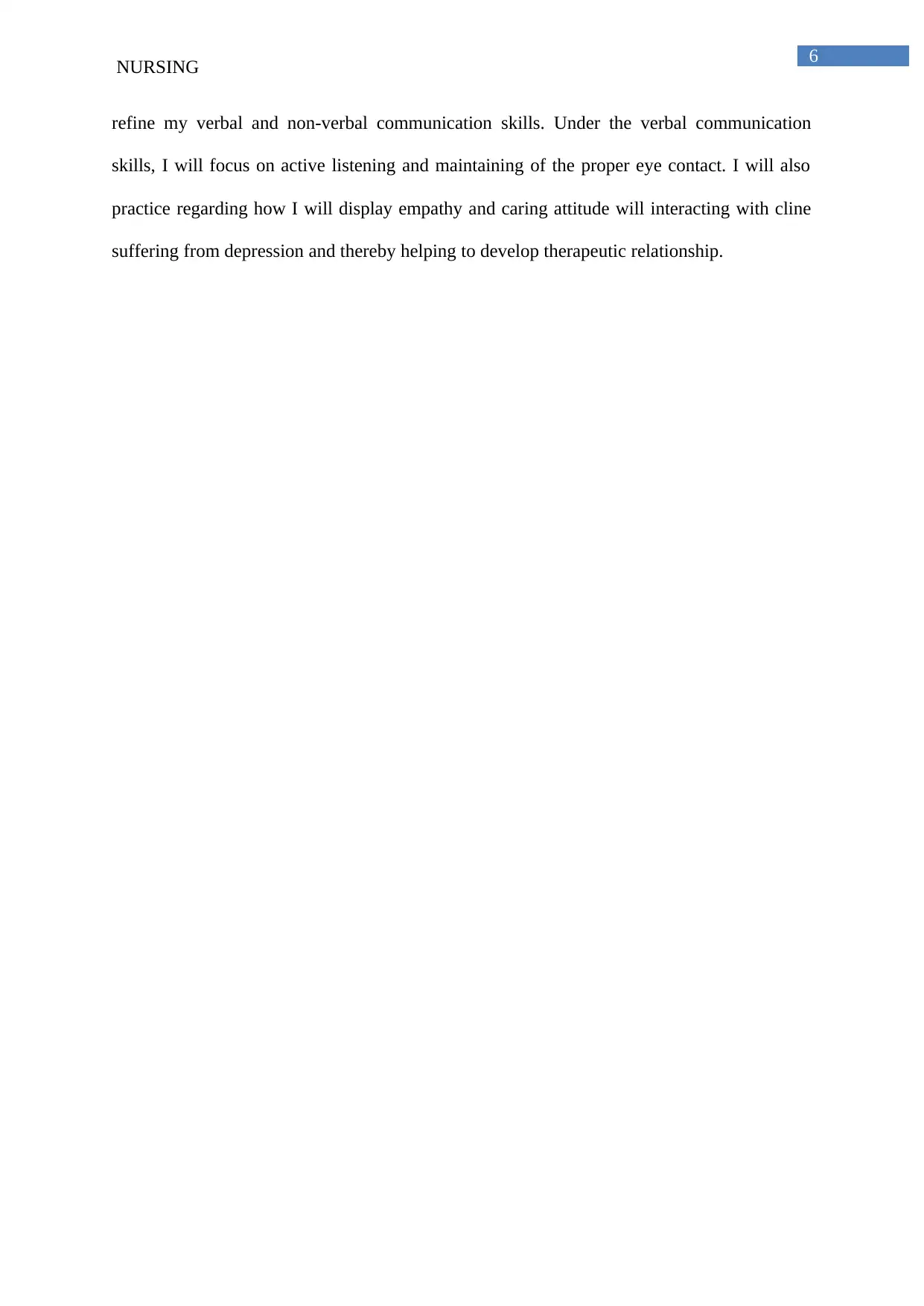
6
NURSING
refine my verbal and non-verbal communication skills. Under the verbal communication
skills, I will focus on active listening and maintaining of the proper eye contact. I will also
practice regarding how I will display empathy and caring attitude will interacting with cline
suffering from depression and thereby helping to develop therapeutic relationship.
NURSING
refine my verbal and non-verbal communication skills. Under the verbal communication
skills, I will focus on active listening and maintaining of the proper eye contact. I will also
practice regarding how I will display empathy and caring attitude will interacting with cline
suffering from depression and thereby helping to develop therapeutic relationship.
Paraphrase This Document
Need a fresh take? Get an instant paraphrase of this document with our AI Paraphraser
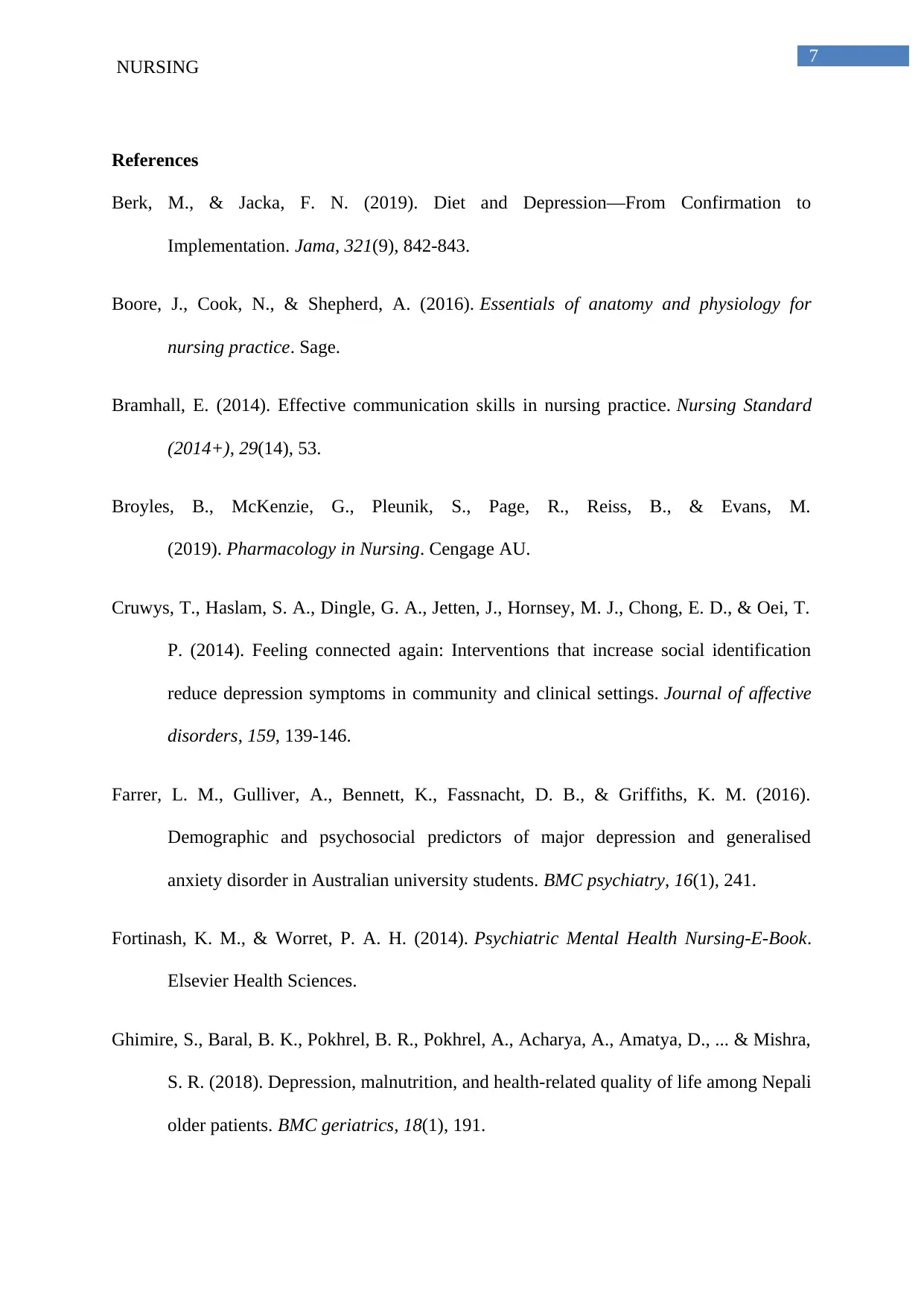
7
NURSING
References
Berk, M., & Jacka, F. N. (2019). Diet and Depression—From Confirmation to
Implementation. Jama, 321(9), 842-843.
Boore, J., Cook, N., & Shepherd, A. (2016). Essentials of anatomy and physiology for
nursing practice. Sage.
Bramhall, E. (2014). Effective communication skills in nursing practice. Nursing Standard
(2014+), 29(14), 53.
Broyles, B., McKenzie, G., Pleunik, S., Page, R., Reiss, B., & Evans, M.
(2019). Pharmacology in Nursing. Cengage AU.
Cruwys, T., Haslam, S. A., Dingle, G. A., Jetten, J., Hornsey, M. J., Chong, E. D., & Oei, T.
P. (2014). Feeling connected again: Interventions that increase social identification
reduce depression symptoms in community and clinical settings. Journal of affective
disorders, 159, 139-146.
Farrer, L. M., Gulliver, A., Bennett, K., Fassnacht, D. B., & Griffiths, K. M. (2016).
Demographic and psychosocial predictors of major depression and generalised
anxiety disorder in Australian university students. BMC psychiatry, 16(1), 241.
Fortinash, K. M., & Worret, P. A. H. (2014). Psychiatric Mental Health Nursing-E-Book.
Elsevier Health Sciences.
Ghimire, S., Baral, B. K., Pokhrel, B. R., Pokhrel, A., Acharya, A., Amatya, D., ... & Mishra,
S. R. (2018). Depression, malnutrition, and health-related quality of life among Nepali
older patients. BMC geriatrics, 18(1), 191.
NURSING
References
Berk, M., & Jacka, F. N. (2019). Diet and Depression—From Confirmation to
Implementation. Jama, 321(9), 842-843.
Boore, J., Cook, N., & Shepherd, A. (2016). Essentials of anatomy and physiology for
nursing practice. Sage.
Bramhall, E. (2014). Effective communication skills in nursing practice. Nursing Standard
(2014+), 29(14), 53.
Broyles, B., McKenzie, G., Pleunik, S., Page, R., Reiss, B., & Evans, M.
(2019). Pharmacology in Nursing. Cengage AU.
Cruwys, T., Haslam, S. A., Dingle, G. A., Jetten, J., Hornsey, M. J., Chong, E. D., & Oei, T.
P. (2014). Feeling connected again: Interventions that increase social identification
reduce depression symptoms in community and clinical settings. Journal of affective
disorders, 159, 139-146.
Farrer, L. M., Gulliver, A., Bennett, K., Fassnacht, D. B., & Griffiths, K. M. (2016).
Demographic and psychosocial predictors of major depression and generalised
anxiety disorder in Australian university students. BMC psychiatry, 16(1), 241.
Fortinash, K. M., & Worret, P. A. H. (2014). Psychiatric Mental Health Nursing-E-Book.
Elsevier Health Sciences.
Ghimire, S., Baral, B. K., Pokhrel, B. R., Pokhrel, A., Acharya, A., Amatya, D., ... & Mishra,
S. R. (2018). Depression, malnutrition, and health-related quality of life among Nepali
older patients. BMC geriatrics, 18(1), 191.
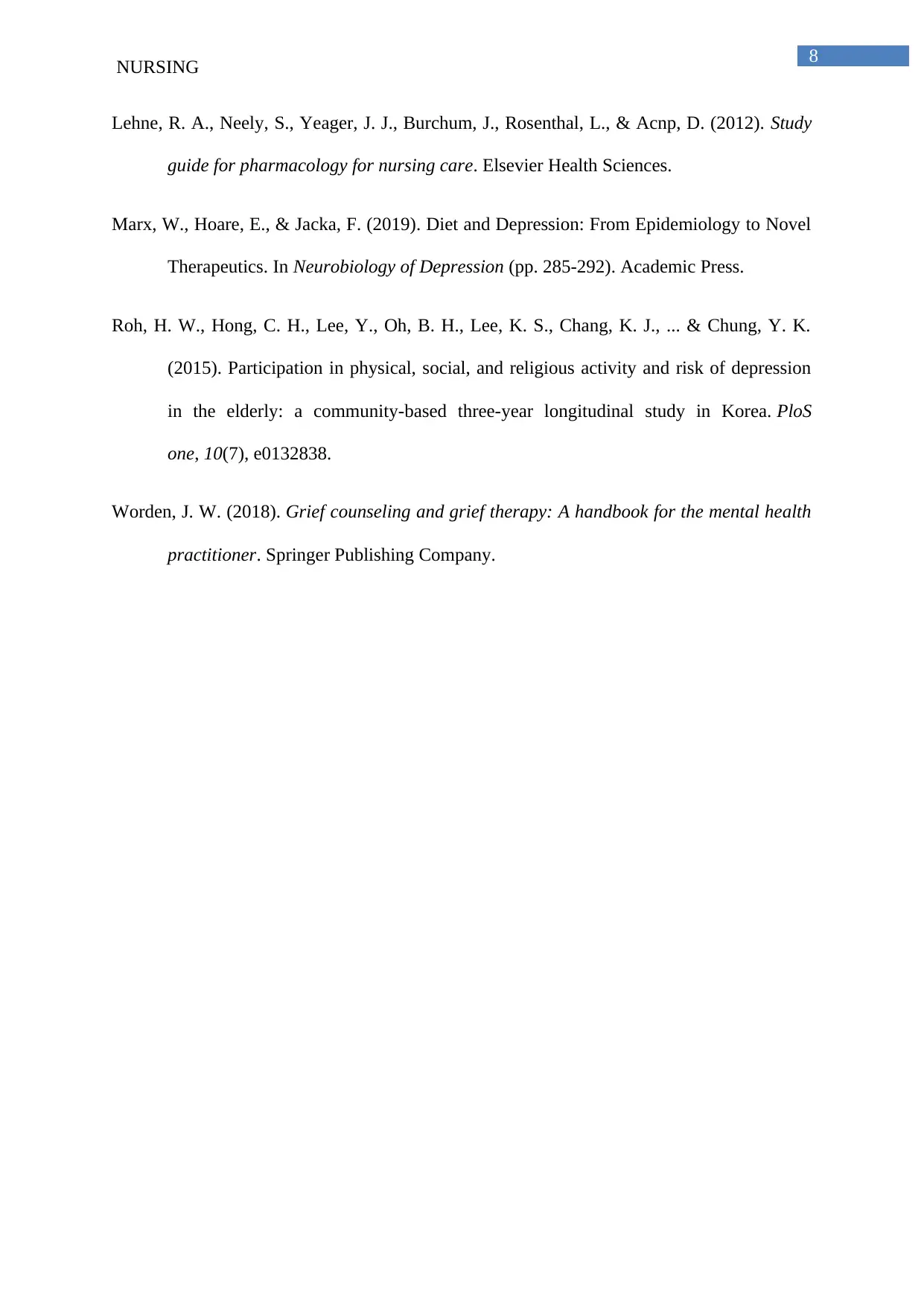
8
NURSING
Lehne, R. A., Neely, S., Yeager, J. J., Burchum, J., Rosenthal, L., & Acnp, D. (2012). Study
guide for pharmacology for nursing care. Elsevier Health Sciences.
Marx, W., Hoare, E., & Jacka, F. (2019). Diet and Depression: From Epidemiology to Novel
Therapeutics. In Neurobiology of Depression (pp. 285-292). Academic Press.
Roh, H. W., Hong, C. H., Lee, Y., Oh, B. H., Lee, K. S., Chang, K. J., ... & Chung, Y. K.
(2015). Participation in physical, social, and religious activity and risk of depression
in the elderly: a community-based three-year longitudinal study in Korea. PloS
one, 10(7), e0132838.
Worden, J. W. (2018). Grief counseling and grief therapy: A handbook for the mental health
practitioner. Springer Publishing Company.
NURSING
Lehne, R. A., Neely, S., Yeager, J. J., Burchum, J., Rosenthal, L., & Acnp, D. (2012). Study
guide for pharmacology for nursing care. Elsevier Health Sciences.
Marx, W., Hoare, E., & Jacka, F. (2019). Diet and Depression: From Epidemiology to Novel
Therapeutics. In Neurobiology of Depression (pp. 285-292). Academic Press.
Roh, H. W., Hong, C. H., Lee, Y., Oh, B. H., Lee, K. S., Chang, K. J., ... & Chung, Y. K.
(2015). Participation in physical, social, and religious activity and risk of depression
in the elderly: a community-based three-year longitudinal study in Korea. PloS
one, 10(7), e0132838.
Worden, J. W. (2018). Grief counseling and grief therapy: A handbook for the mental health
practitioner. Springer Publishing Company.
1 out of 9
Related Documents
Your All-in-One AI-Powered Toolkit for Academic Success.
+13062052269
info@desklib.com
Available 24*7 on WhatsApp / Email
![[object Object]](/_next/static/media/star-bottom.7253800d.svg)
Unlock your academic potential
© 2024 | Zucol Services PVT LTD | All rights reserved.





